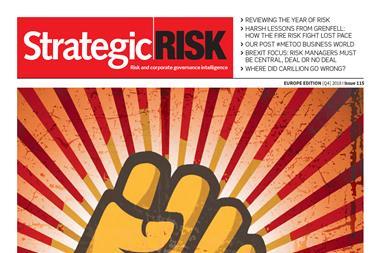There are perils to insuring with unrated subsidiaries regardless of whom their parent is, warns Peter Hughes
There is in insurance, as in most other areas of life, a lot of comfort to be derived from a familiar name. It is understandable, when placing business, to expect that any company that carries the name, or even the ownership, of a familiar, big name insurer, will represent a safe and long-standing arrangement. But what happens to the relationship with an insurer once it has ceased writing new business? And when that insurer is part of a larger group, how will the group look after its subsidiary once it ceases to generate new revenue?
Standard & Poor’s methodology for rating insurance groups is predicated on questions such as these, and this article explains the dangers of dealing with unrated subsidiaries, how to view subsidiary insurers and how S&P’s analysts allocate ratings across a group.
Recent research by accountant PWC revealed that the liabilities of insurers in run-off in Europe amounted to more than €200bn. KPMG announced in their 2006 survey that the outstanding liabilities of UK non-life insurers alone amounted to £38bn – some 23% of the current UK non-life market. PWC suggested that the run-off market in Germany and Switzerland is larger than the UK.
Consider also the fact that, of 231 UK companies that were historically rated by S&P, but no longer have a rating having ceased to underwrite, over 70% were subsidiaries of other insurers.
The extraordinary picture that emerges from this is one of an insurance market that is like an iceberg, with the part above the water, the insurers that policyholders deal with today, representing only a part of the whole picture. This is not a desirable situation when transparency and an understanding of financial security are paramount.
It won’t be news to anyone that insurers cease underwriting – that’s the main reason that the modern risk manager uses our ratings as an integral part of the buying decision. But what might be new is how many of these are subsidiaries of larger groups. Of course in many instances, when an insurer closes down its subsidiary, it will continue to service claims in much the same way as it will for policyholders who are still insured with ongoing subsidiaries. But it is not always the case, especially when the subsidiary is operating in different markets – countries, classes of business, or, for example, industrial business rather than retail.
Cutting the apron strings
This means that when a company says that it is ‘part of XYZ group, which has an A range rating from S&P’ it is not necessarily a statement that should give you confidence that the subsidiary has the same financial characteristics as its parent. History has taught us that, when push comes to shove, the parent will let the subsidiary go if the numbers are bad enough.
For this reason Standard & Poor’s has developed a detailed methodology for rating insurance subsidiaries. In broad terms, this takes the following form.
It starts with two questions:
• What is the overall financial security of the group?
• How do the subsidiaries of the group fit into the overall structure?
Key to the latter point is the question: what would be the rationale for the parent group's wanting to support an ailing subsidiary or conversely wanting to sell, or 'walk away' from a subsidiary?
Meanwhile, for many groups it is appropriate to evaluate operating insurers in the context of the aggregate financial security of their group. Even if a group isolates its riskier lines of business into a separate insurance subsidiary, such potential risk should not be ignored when analysing the group. The methodology for analysing groups attempts to provide a consistent framework to look at an entire insurance organisation.
Group analysis
Standard & Poor's methodology for analysing insurance groups is especially useful when applied to multi-line insurance organisations, and to organizations with multi-product and/or geographic subsidiaries.
The first element of this exercise is to establish a financial strength rating for the entire insurance group. This analysis is based on a combination of consolidated and separate operating company financial statements.
The capital strength of the group is based on a consolidated capital allocation model, as well as on a review of individual company capital adequacy. Meanwhile, the business review and operating performance characteristics of each line of business are based on the individual market position and profitability of the core and strategically important subsidiaries.
“The extraordinary picture that emerges from this is one of an insurance market that is like an iceberg, with the part above the water, the insurers that policyholders deal with today, representing only a part of the whole picture.
By looking at all material operating units, which are measured by size or risk, a rating of the entire group is determined. This becomes the reference point for the ratings of the various subsidiaries. In the second phase of the analysis, the subsidiaries are classified into three groups:
• core subsidiaries;
• strategically important subsidiaries
• non-strategic subsidiaries.
Each company within a group must satisfy specific criteria to achieve ‘core’ or ‘strategically important’ status. Otherwise Standard & Poor’s will treat them as being ‘non-strategic’.
Although not all characteristics need to be met for a subsidiary to qualify as either core or strategically important, in both cases capital adequacy standards must be achieved and maintained.
Rating group subsidiaries
The rating process begins with the notional group rating, which can then be applied to all subsidiaries deemed to be core - those to which the group has demonstrated implicit
commitment. Strategically important subsidiaries are then rated on a stand-alone basis, focusing on operating performance, market position, and capital adequacy. However, based on Standard & Poor's analysis of their importance to the entire insurance organisation, strategically important subsidiaries will receive one rating category of benefit, up to one notch below the group's rating - a notch being the minor differentiator used by Standard & Poor's; for example the difference between 'BBB-' and 'BBB'.
This ensures an explicit ratings differential between core and strategically important subsidiaries. Non-strategic subsidiaries, meanwhile, are normally rated solely on a stand-alone basis. One notch of credit may occasionally be given if the subsidiary is not an obvious candidate for sale in the short-term or if financial help from the parent is likely if it were to experience financial difficulties.
Special situations
There may be rare situations in which a core or strategically important subsidiary is deemed by Standard & Poor’s to have characteristics in its own right, other than solely having superior capital adequacy, to warrant consideration for a rating above the rating of the entire group.
Such subsidiaries could be rated up to two notches above the group (ie raised from ‘A’ to ‘AA-’). In such situations, however, the subsidiary must exhibit superior business and operating characteristics. It must also be able to operate on its own, independent of the group, in addition to maintaining the appropriate capital.
Outside minority ownership of 10%-20% and totally separate distribution networks would be important characteristics in supporting a higher rating. In addition, an economic incentive for a higher rating could also be helpful.
In such situations, the capital necessary to support this higher rated subsidiary would be deconsolidated from the analysis of the total consolidated capital position. This, in turn, could reduce the group rating, which could restrict the subsidiary’s initially determined higher rating.
It comes down to this
It is vital to remember that a subsidiary does not necessarily have the same financial characteristics as its parent. So the next time someone says “we’re part of the XYZ group, which has an A rating”, it would be prudent to respond with “that might be the case, but what’s your rating?”
Peter Hughes is vice-president, Standard & Poor’s Ratings Services, www.standardandpoors.com




















No comments yet